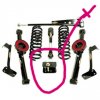dang it!!!!!!!!!!!!!!! i just typed about a half hour explanation and hit some button on my laptop that erased it all?????????????? dang!
i'll try again:
think of only the lower arm in your mind. you are standing on level ground and the front of the car is to your right.
the lower arm from rear to front should point downward about 2 degrees. why?
the first reaction under the shock of dumping the clutch is for the rear housing to rotate rearward. therefore pushing the energy downward and forward thru the lower arms. this pushes downward on the frame to weight and plant the tires. the very next reaction is for the rear housing to seperate from the body (because of the upper arm angle) when the housing seperates, it pushes even harder on the tires and next, the lower arm angle has changed to now pushing forward on the car. (isnt this the direction we REALLY wanted to go?) when the car is at rest, with a 2 degree down angle, this also contributes to our instant center being under the middle of the car.
once we set a car to ride with the lower angle correct, we rarely ever change it.
Uppers: rear to front can be nearly 7 degrees downward. remember, the uppers are a pivot point and get pulled on under power. the amount of angle down determines how hard the housing will be pulled downward. the down angle also contributes to the instant center being under the middle of the car. on sticky trax and with good tires, you dont want all that bite or violent reaction so we (take some "bite" out of it) by raising the front of the uppers to a less violent (power robbing) reaction.
have u ever wondered why a jacked up chevelle will wheelhop? the lower bar angles are up in the front. first reaction, push upward on the body. second, as the rear seperates, lift the body more, it then falls back down and starts the bounce. simple repeat that process quickly........wheelhop.
preload: when you have the car at rest and ride height, there will always be a spot in the upper right bar where you can adjust it to nuetral or NO LOAD. it will be loose in your hand. get to this spot, turn the bar (lengthen) by hand until snug, then LENGTHEN the upper 1 or 2 flats (no more than 2) (1/6th of a turn is a flat) this preloads the 4 link system the correct way.
looking from the rear of the car:
the driveshaft is trying to plant the left tire and raise the right tire.
COUNTER ACTION: the engine is trying to raise the left side of the body and plant the right side
thats why a bag in the right rear helps. a shock hard to compress on the Right and a shock hard to extend on the left is a good theory.......but you have to be careful using 2 differant shocks so that the car wont feel funny down the rest of the track. (theres more to the pass than the launch)
these are my own words so i'll put my name to it. Bob walker Jr. but the theory of all this has been around for ever.
if u get all this balanced, success




 thank you. What effect does lowering the lower arms at the frame have in combination with the above adjustment? If I lower the lower arms at the frame under the car it will help lower the rear of the car. Right now the car sits a little lower in the front by about 2" or more.
thank you. What effect does lowering the lower arms at the frame have in combination with the above adjustment? If I lower the lower arms at the frame under the car it will help lower the rear of the car. Right now the car sits a little lower in the front by about 2" or more.

